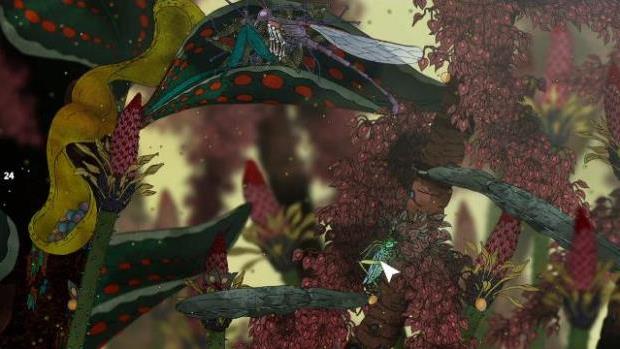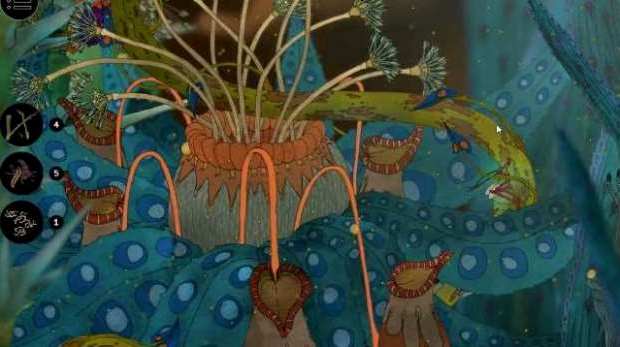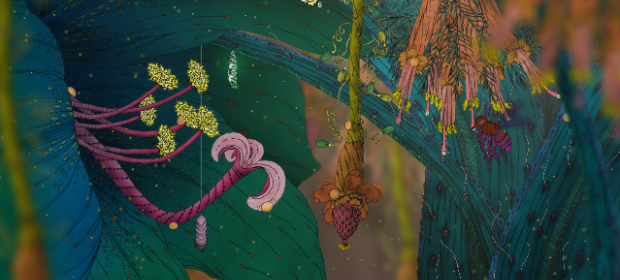New point and click puzzle game Morphopolis already comes with a lot of critical acclaim behind it. Before its release it has already won a Design Award from the Association of Illustrators, as well as being part of the special selection at Rezzed. Arriving with such high praise, gamers should expect big things from this hidden object title from first-time developers Micro Macro.
Morphopolis is concerned with an Aphid who wishes to re-unite with its lost companion – but in practice, there is no exposition or set-up to explain this. When playing, you are thrown straight into the first scene and in no way is any sort of narrative conveyed. This is disappointing, as the developers have mooted the title as being story-driven, but it most certainly isn’t. The only way I knew about the fact that there was even a narrative at all was from reading the developer’s blurb.

Action takes place from the point of view of an insect, in a micro-world where twigs form bridges and flower stems ladders. The gamer begins as a tiny Aphid, and through the five playable levels must upgrade to larger, more mobile insects in order to progress. By solving puzzles, and collecting objects hidden in the scenery, you build up parts of these larger insects and, when complete, perform a somewhat disgusting move where your character burrows into the head of the new insect, thus taking control of their body. Lovely.
The majority of Morphopolis is a very simple hidden object search. You move between three or four scenes per stage (only one in the first stage, but levels get progressively longer as play goes on), tapping or clicking on objects on-screen, trying to find a pre-determined number of different items. Your “shopping list”, of sorts, is displayed on the left-hand side of the screen, keeping track of how many items are left for you to collect before you can complete the stage. This is adventure gaming at its simplest, and is far from demanding. Hidden object games seem a product of point and click games becoming more casual, so if you like your adventures light and non-taxing, this may be right up your street.

An in-game hint system is present, which takes a few minutes to charge each time, but will highlight objects to pick up so you won’t be left searching blindly for long if you are stuck. There are some more complex puzzles hidden within the levels, such as a game of pairs where you have to match up the number of spots on the back of beetles, or a kind of Lights-Out game that involves switching glowing gems. These aren’t especially difficult and can mainly be solved by trial and error, and a little patience.
Seeing as the story and gameplay aren’t exactly revolutionary, it is left down to the much-touted design to carry the game, and it is quite a good-looking title. The insect world created is familiar to us, but alien in its own way – what with the action all being shown from a viewpoint we aren’t used to. The sprawling levels created by tiny organic items are quite clever, using environmental elements in interesting ways. The colour palette has been played with, so rather than muted browns and greens that one might expect from an organic environment, everything is bright and bold. The visuals are certainly eye-catching, but if you are scared of insects beware – the level of realism may make you squeamish.

The whole package is rounded off by a suite of relaxed music, which obviously is meant to complement the slow-paced and non-taxing gameplay. The music has a hint of jungle drums or tribal music to it, playing on the idea that the mini-world created in Morphpopolis is like a dangerous jungle – but mostly the soundtrack fades into simple background ambiance and is never used to accentuate what is happening on-screen.
VERDICT: Whilst the design of Morphopolis may have won it many fans already, this does seem to be very much a case of style over substance. The story is non-existent and the gameplay itself is woefully simple, meaning that the five levels are only likely to take even fairly casual puzzle-gamers more than twenty minutes or so each to complete. The only thing likely to slow you down is the lack of a save system – meaning you cannot leave a level part-way through and come back to it later. This is infuriating, and quite frankly a terrible design choice for a casual game – harking back to much less forgiving times. Marry that with the fact that level loading times are ridiculously long, and you soon realise that the majority of your time with Morphopoils won’t actually be occupied with playing. This is more an art experiment than a game.

POOR. Games tagged 4/10 will be playable, perhaps even enjoyable, but will be let down by a slew of negative elements that undermine their quality and value. Best avoided by any but hardcore genre fans.
Review code provided by publisher.






